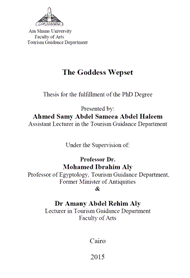| Main » Ad Board » ДРЕВЕН ЕГИПЕТ И АФРИКА » Религия и философия |
Ahmed Samy - The Goddess Wepset
| 26.12.2019, 10:36 | |
Богинята Уепсет ("Изгарящата") е войнствено божество-покровител, свързано с урея на фараона. Почитана е като притежаваща апотропична сила, която отблъсква враговете и е изобразявана като кобра. В този свой аспект тя е и "Окото на Ра" според Текстовете от саркофазите. През епохата на Новото царство тя е унищожител на враговете на Озирис. Нейни храмове има на о. Бига и различни места в Долна Нубия. Ahmed Samy Abdel-Sameea Abdel-Haleem - The Goddess Wepset, Cairo, Ain Shams University, 2015 - на английски език, от Google Docs,формат PDF. Сваляне с ляв бутон (downloading by left button) от страницата на предоставящия сървър, после през бутона стрелка надолу/after by down arrow button.
| |
| Views: 1265 | Placed till: 26.01.2020 | Rating: 0.0/0 | |

